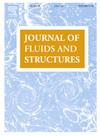Numerical modeling of fluid-structure interactions by using a hybrid method of IB-LBM and ANCF
IF 3.5
2区 工程技术
Q1 ENGINEERING, MECHANICAL
引用次数: 0
Abstract
The study on coupling dynamics of flexible multibody-fluid interactions is of paramount importance for the design of aircraft, flying biomimetic systems and underwater soft robots. This paper presents a novel computational methodology for simulating flexible multibody-fluid interactions. The methodology combines the lattice Boltzmann method to model fluid dynamics and the absolute nodal coordinate formulation to describe flexible multibody systems. Then, it uses the immersed boundary method to simulate moving and deforming boundaries within fluid flows. The innovation of the methodology lies in two aspects. First, the shear-improved Smagorisky model is introduced into the flexible multibody-fluid coupling to efficiently capture turbulent flows under large motions and significant rotations. Second, a structural predictor is used to effectively reduce the interaction time-lag problems so as to assure the consistency of dynamic responses and energy conservation at the interface. The proposed methodology is validated through three classical benchmarks first, and then the fluttering dynamics of a flexible biomimetic butterfly in air is simulated. All numerical simulations demonstrate that the new methodology can effectively address the complex coupling dynamics of flexible multibody-fluid systems.
基于IB-LBM和ANCF混合方法的流固耦合数值模拟
柔性多体流体相互作用耦合动力学研究对于飞行器、飞行仿生系统和水下软机器人的设计具有重要意义。本文提出了一种新的模拟柔性多体流体相互作用的计算方法。该方法结合了晶格玻尔兹曼方法来模拟流体动力学和绝对节点坐标公式来描述柔性多体系统。然后,采用浸入边界法模拟流体内部的移动和变形边界。方法论的创新体现在两个方面。首先,将剪切改进的Smagorisky模型引入柔性多体流耦合中,以有效捕获大运动和大旋转下的湍流。其次,利用结构预测器有效地减少了相互作用时滞问题,保证了动态响应的一致性和界面处的能量节约。首先通过三个经典基准对所提出的方法进行了验证,然后对柔性仿生蝴蝶在空气中的扇动动力学进行了仿真。数值模拟结果表明,该方法能有效地解决多体流体系统的复杂耦合动力学问题。
本文章由计算机程序翻译,如有差异,请以英文原文为准。
求助全文
约1分钟内获得全文
求助全文
来源期刊

Journal of Fluids and Structures
工程技术-工程:机械
CiteScore
6.90
自引率
8.30%
发文量
173
审稿时长
65 days
期刊介绍:
The Journal of Fluids and Structures serves as a focal point and a forum for the exchange of ideas, for the many kinds of specialists and practitioners concerned with fluid–structure interactions and the dynamics of systems related thereto, in any field. One of its aims is to foster the cross–fertilization of ideas, methods and techniques in the various disciplines involved.
The journal publishes papers that present original and significant contributions on all aspects of the mechanical interactions between fluids and solids, regardless of scale.
 求助内容:
求助内容: 应助结果提醒方式:
应助结果提醒方式:


